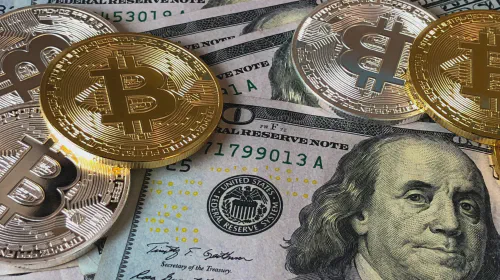The Mystery of the Message in the Bitcoin Genesis Block
Salomon Kisters
Apr 29, 2022This post may contain affiliate links. If you use these links to buy something we may earn a commission. Thanks!
Bitcoin. Here’s a word you might have heard a lot during the past years. The deeper the crisis the world drowns into, the more popular this word became.
Bitcoin’s popularity seems to be related to world problems – the bigger the problems, the more popular Bitcoin and crypto, in general, get.
Humanity has been hopping from one crisis to another, especially since 2020, when the pandemic hit. With each passing day, the importance of financial freedom becomes more relevant. This is where crypto and especially Bitcoin, enter the picture.
Satoshi Nakamoto’s creation came in dark times amidst a global recession. It’s in such hopeless times when it’s shining the brightest.
Satoshi Nakamoto is the pseudonym used by the person or group who created Bitcoin, authored its white paper, and developed and deployed its original reference implementation. The Bitcoin genesis block is the key to identifying Satoshi himself.
Here’s all you have to know about the amazing secrets behind the genesis block that laid the foundation for Bitcoin.
How it all began
On January 3, 2022, Bitcoin celebrated its 13th anniversary. It was the day when the genesis block was mined.
What is the Genesis Block, and why is it important to know a thing or two about it?
Because this lies at the very foundation of Bitcoin, of the whole future of finance, as envisioned by Satoshi Nakamoto.
Indirectly, by mining the genesis block, Satoshi spawned the 21 million BTC, which make up Bitcoin’s total supply.
Modern versions of Bitcoin number this as block 0, but very early versions have counted it as block number 1.
Interestingly, the genesis block is almost always hardcoded into the software of the applications that use its blockchain. The genesis block is unique because it does not reference a previous block.
For Bitcoin and almost all its derivatives, it produces an unspendable subsidy.
Five days passed before Satoshi released the software to the public. In other words, the Genesis Block is considered the very start of the Bitcoin blockchain and the beginning of the crypto revolution.
As the very first block ever created, the genesis block is the start of the immutable database that we call today the Bitcoin blockchain. It is the first example of a peer-to-peer digital currency secured by solid cryptographic principles.
The uniqueness of the genesis block
Every successive block is linked to the previous one, which is crucial to the security of the blockchain, according to AllianceBlock Founder and CTO Matthijs de Vries. He said the following in a Decrypt interview: “Each block contains information about the transactions in that block and a hash from the previous block it’s linked to. The next block will contain the hash of all the data from the previous block, and so on: ’the Merkle tree.'”
He continued and explained that all this would ensure that if one transaction gets altered, the complete chain will eventually get corrupted.
He also explained to Decrypt publication that the Genesis Block, being the first one in existence, cannot be linked to a previous one. He said that this very fact offers it some pretty strange features.
“This likely led to Satoshi’s decision to not submit the 50 BTC reward to Bitcoin’s transaction database,” de Vries noted as per Decrypt.
One other issue worth mentioning is that the Genesis Block was almost certainly mined by a computer that used its CPU, compared to the vast majority of the blocks that are mined these days.
The first block only had a difficulty of 1, which means that the mining process was almost instant. To get a better image, today, the block mining difficulty is at 21.4 trillion, and it’s still growing! This means that the mining process requires specialized mining equipment – hardware known as ASIC to remain competitive.
Another interesting fact worth mentioning is that there’s been a six-day delay between creating the first block and the second one, rather than the usual 10-minute delay that we can see today.
This led some voices in the crypto space to speculate the fact that Satoshi was drawing parallels and emulating the story of creation from the Book of Genesis. Here, the Judeo-Christian God is creating Earth and everything around the planet in 7 days – the last day is a day of rest.
The Bitcoin whitepaper and early days
On October 31, 2008, Bitcoin was revealed via a popular cryptography mailing list.
This was the day when Bitcoin’s creator, Satoshi Nakamoto, published the BTC whitepaper called “Bitcoin: A Peer-to-Peer Electronic Cash System.” Three months after this important event, the Bitcoin network became operational.
The Bitcoin network first went live on January 3, 2009, but it’s essential to note that it took more than a week before the first BTC transaction was actually made.
A tweet posted on January 12, 2008, shows that early cypherpunk Hal Finney was the very first person to receive Bitcoin on the network.
This transaction was a direct transfer of 10 BTC from Satoshi to Finney.
It’s believed that Satoshi did not spend any of the estimated 1.1 million BTC hoarded. The value of Bitcoin was arbitrary for the first year. One of the first commercial purchases that used the digital asset occurred in May 2010. Back then, computer programmer Laszlo Hanyecz paid 10,000 BTC for two pizzas worth $41.
An easter egg in the genesis block
The Bitcoin whitepaper was released back in November 2008 when the world was drowning in a massive global recession.
That period was known as the Great Recession, and it was a time when national economies were seeing a huge decline. Many countries were seeing their unemployment rates going to the moon. The stock market was crashing, and the housing markets were also plummeting.
Private and commercial banks were collapsing, and financial institutions worldwide, along with governments, were implementing fiscal policies that were designed to stimulate the struggling economies of nations. There was quantitative easing and slashing of interest rates by authorities.
To make a reference to this situation, Satoshi made sure to introduce a hidden message on the Genesis Block’s coinbase timestamp parameter – it was referencing The Times newspaper:
“The Times 03/Jan/2009 Chancellor on brink of second bailout for banks *—Satoshi Nakamoto”
He also hid the same text in reverse on line 1616 of Bitcoin’s original code.
As Decrypt notes, this was hidden as the hexadecimal string. When this is converted into text using a HEX to TEXT converter, it unveils the following:
“sknab rof tuoliab dnoces fo knirb no rollecnahC 9002/naJ/30 semiT ehT —Satoshi Nakamoto"
Due to the timing of its release, besides the hidden message included in the Genesis Block, it’s believed that Bitcoin was created to offer an alternative monetary system, a system built to resist the challenges faced by traditional currencies: counterfeiting, inflation, and corruption.
Bitcoin managed to see enormous progress towards becoming what Satoshi intended to make of it.
Finney was also the second person to run Bitcoin apart from receiving the first Bitcoin transaction. He was popular for his work in advanced cryptography systems before passing away due to a rare disease in 2014.
Some conspiracy theories claim that Hal Finney is actually Satoshi Nakamoto. But nobody knows for sure.
True Meanings Carved in Bitcoin
The hash of the Bitcoin genesis block is the following:
000000000019d6689c085ae165831e934ff763ae46a2a6c172b3f1b60a8ce26f
It has two more leading hex zeroes than were required for an early block. The coinbase parameter also includes, along with the normal data, the following text:
The Times 03/Jan/2009 Chancellor on brink of second bailout for banks
This info is intended as proof that the block was created on January 3, 2009, and the comment highlights the massive instability caused by fractional-reserve banking. It may also suggest that Satoshi may have lived in the UK.
“Second bailout for banks” is a detail suggesting that rescuing banks was a problem in a supposedly liberal and capitalist system. All in all, the message highlights the very purpose of Bitcoin.
The London Times’ story called “Chancellor on Brink of Second Bailout for Banks” included in the Genesis Block is a rare piece of financial history that will remain embedded in the collective memory of humanity as the start of a new financial era.
The newspaper is the rarest and the most valuable crypto collectible in existence. Serious collectors are struggling to find the copies – to date, only two of them have been verified.
Closing Words
When Satoshi picked this comment to be introduced in the Genesis Block, he did so for a reason. The comment highlights the disruptive nature of Bitcoin and the revolutionary freedom that is associated with it. It is the true meaning carved in Bitcoin: Ending the control of banks and governments over people’s money.
Stay informed with the latest insights in Crypto, Blockchain, and Cyber-Security! Subscribe to our newsletter now to receive exclusive updates, expert analyses, and current developments directly to your inbox. Don't miss the opportunity to expand your knowledge and stay up-to-date.
Love what you're reading? Subscribe for top stories in Crypto, Blockchain, and Cyber-Security. Stay informed with exclusive updates.
Please note that the Content may have been generated with the Help of AI. The editorial content of OriginStamp AG does not constitute a recommendation for investment or purchase advice. In principle, an investment can also lead to a total loss. Therefore, please seek advice before making an investment decision.

Can The Blockchain Be Hacked Or Attacked?
Blockchain technology and cryptocurrencies have seen a massive surge in popularity. Can they be hacked?

Why Can There Only Be 21 Million Bitcoins? Impact of Bitcoin's Fixed Supply
Discover why there can only be 21 million Bitcoins and the impact of Bitcoin's fixed supply on inflation control and scarcity.

Who Runs Ethereum? Understanding Decentralized Governance
Ethereum has a decentralized governance model, with stakeholders like Ether holders, developers, and miners contributing to decision-making.
Protect your documents
Your gateway to unforgeable data. Imprint the authenticity of your information with our blockchain timestamp